Tesco's International HRM: Structures, Staffing, Rewards and Training
VerifiedAdded on 2021/02/20
|8
|2435
|49
Report
AI Summary
This report provides a detailed analysis of international human resource management (IHRM) practices at Tesco, a multinational corporation. The report begins by examining the organizational structures employed by Tesco, including partnerships and joint ventures, and their effectiveness in managing a diverse workforce across subsidiaries. It then explores the various staffing approaches, namely ethnocentric, polycentric, and geocentric, with a focus on Tesco's adoption of the geocentric approach for its new international operations. The report further delves into international reward and compensation approaches, including the going rate and balance sheet approaches, evaluating their relevance and effectiveness in motivating expatriates. Finally, it discusses cultural awareness training programs and their significance in fostering cooperation and coordination among employees from diverse cultural backgrounds, highlighting Tesco's initiatives in this area, such as the Tesco Academy in Seoul, South Korea. The report concludes with a comprehensive overview of the key aspects of IHRM at Tesco, providing insights into the company's strategies for managing its global workforce.
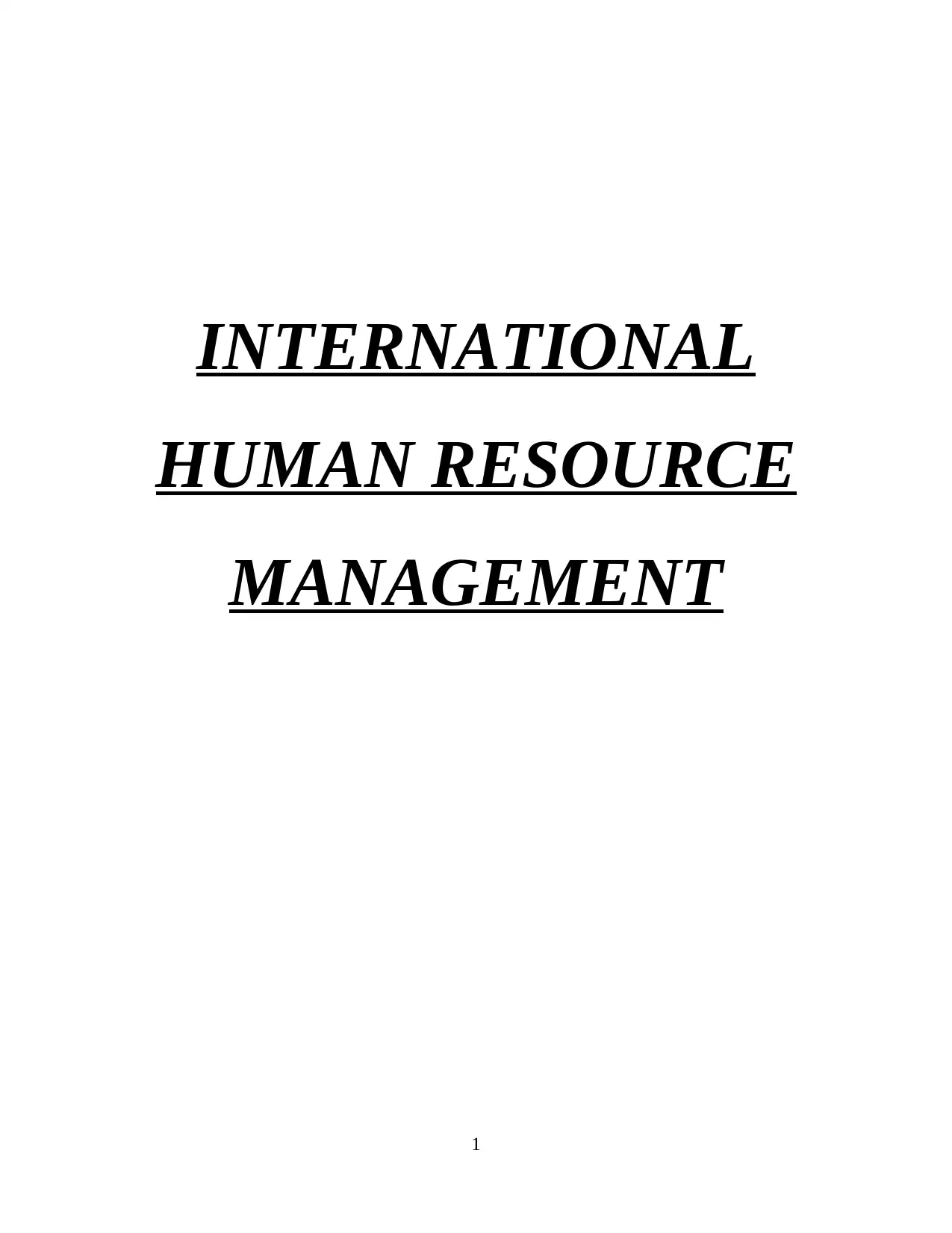
INTERNATIONAL
HUMAN RESOURCE
MANAGEMENT
1
HUMAN RESOURCE
MANAGEMENT
1
Paraphrase This Document
Need a fresh take? Get an instant paraphrase of this document with our AI Paraphraser
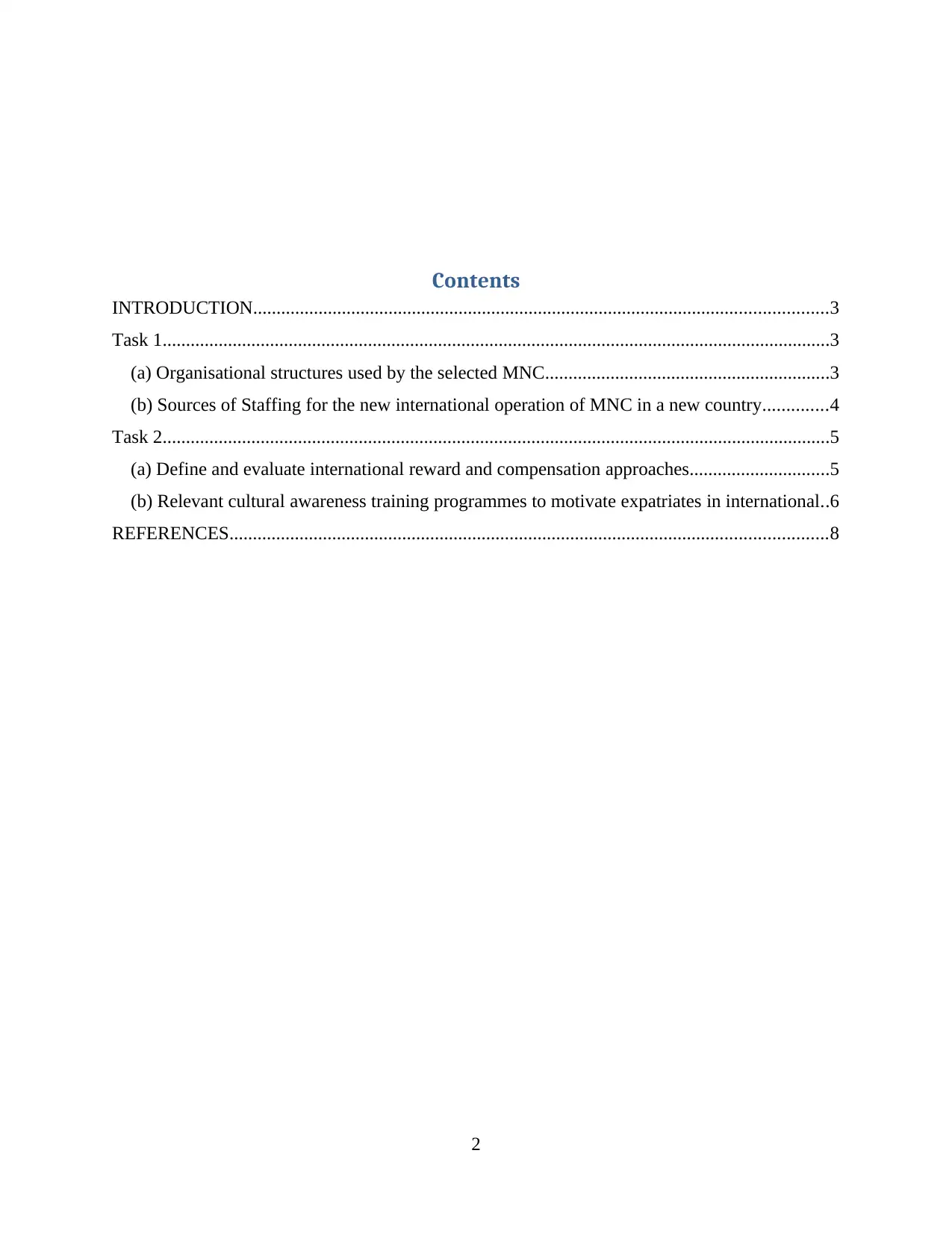
Contents
INTRODUCTION...........................................................................................................................3
Task 1...............................................................................................................................................3
(a) Organisational structures used by the selected MNC.............................................................3
(b) Sources of Staffing for the new international operation of MNC in a new country..............4
Task 2...............................................................................................................................................5
(a) Define and evaluate international reward and compensation approaches..............................5
(b) Relevant cultural awareness training programmes to motivate expatriates in international..6
REFERENCES................................................................................................................................8
2
INTRODUCTION...........................................................................................................................3
Task 1...............................................................................................................................................3
(a) Organisational structures used by the selected MNC.............................................................3
(b) Sources of Staffing for the new international operation of MNC in a new country..............4
Task 2...............................................................................................................................................5
(a) Define and evaluate international reward and compensation approaches..............................5
(b) Relevant cultural awareness training programmes to motivate expatriates in international..6
REFERENCES................................................................................................................................8
2
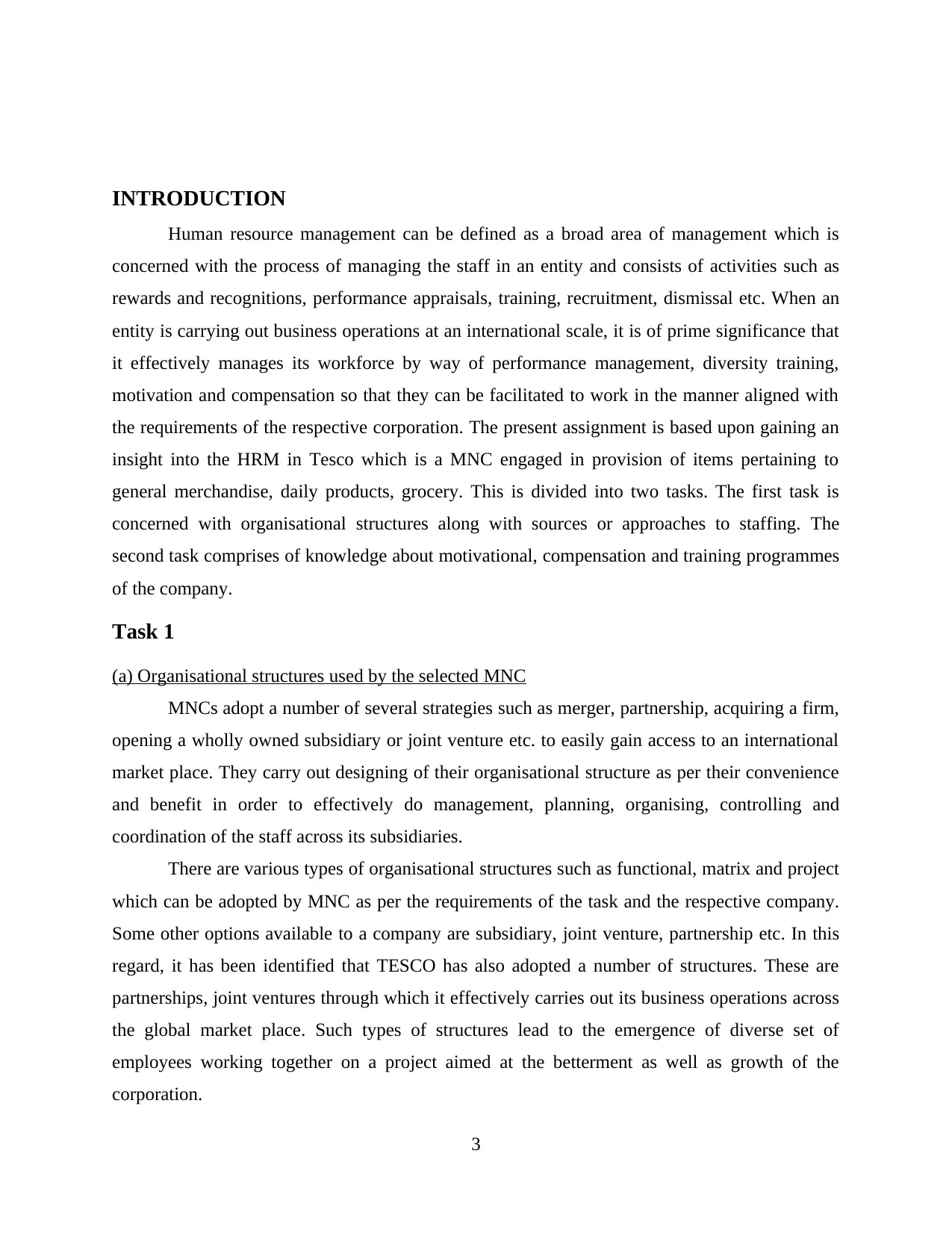
INTRODUCTION
Human resource management can be defined as a broad area of management which is
concerned with the process of managing the staff in an entity and consists of activities such as
rewards and recognitions, performance appraisals, training, recruitment, dismissal etc. When an
entity is carrying out business operations at an international scale, it is of prime significance that
it effectively manages its workforce by way of performance management, diversity training,
motivation and compensation so that they can be facilitated to work in the manner aligned with
the requirements of the respective corporation. The present assignment is based upon gaining an
insight into the HRM in Tesco which is a MNC engaged in provision of items pertaining to
general merchandise, daily products, grocery. This is divided into two tasks. The first task is
concerned with organisational structures along with sources or approaches to staffing. The
second task comprises of knowledge about motivational, compensation and training programmes
of the company.
Task 1
(a) Organisational structures used by the selected MNC
MNCs adopt a number of several strategies such as merger, partnership, acquiring a firm,
opening a wholly owned subsidiary or joint venture etc. to easily gain access to an international
market place. They carry out designing of their organisational structure as per their convenience
and benefit in order to effectively do management, planning, organising, controlling and
coordination of the staff across its subsidiaries.
There are various types of organisational structures such as functional, matrix and project
which can be adopted by MNC as per the requirements of the task and the respective company.
Some other options available to a company are subsidiary, joint venture, partnership etc. In this
regard, it has been identified that TESCO has also adopted a number of structures. These are
partnerships, joint ventures through which it effectively carries out its business operations across
the global market place. Such types of structures lead to the emergence of diverse set of
employees working together on a project aimed at the betterment as well as growth of the
corporation.
3
Human resource management can be defined as a broad area of management which is
concerned with the process of managing the staff in an entity and consists of activities such as
rewards and recognitions, performance appraisals, training, recruitment, dismissal etc. When an
entity is carrying out business operations at an international scale, it is of prime significance that
it effectively manages its workforce by way of performance management, diversity training,
motivation and compensation so that they can be facilitated to work in the manner aligned with
the requirements of the respective corporation. The present assignment is based upon gaining an
insight into the HRM in Tesco which is a MNC engaged in provision of items pertaining to
general merchandise, daily products, grocery. This is divided into two tasks. The first task is
concerned with organisational structures along with sources or approaches to staffing. The
second task comprises of knowledge about motivational, compensation and training programmes
of the company.
Task 1
(a) Organisational structures used by the selected MNC
MNCs adopt a number of several strategies such as merger, partnership, acquiring a firm,
opening a wholly owned subsidiary or joint venture etc. to easily gain access to an international
market place. They carry out designing of their organisational structure as per their convenience
and benefit in order to effectively do management, planning, organising, controlling and
coordination of the staff across its subsidiaries.
There are various types of organisational structures such as functional, matrix and project
which can be adopted by MNC as per the requirements of the task and the respective company.
Some other options available to a company are subsidiary, joint venture, partnership etc. In this
regard, it has been identified that TESCO has also adopted a number of structures. These are
partnerships, joint ventures through which it effectively carries out its business operations across
the global market place. Such types of structures lead to the emergence of diverse set of
employees working together on a project aimed at the betterment as well as growth of the
corporation.
3
⊘ This is a preview!⊘
Do you want full access?
Subscribe today to unlock all pages.

Trusted by 1+ million students worldwide
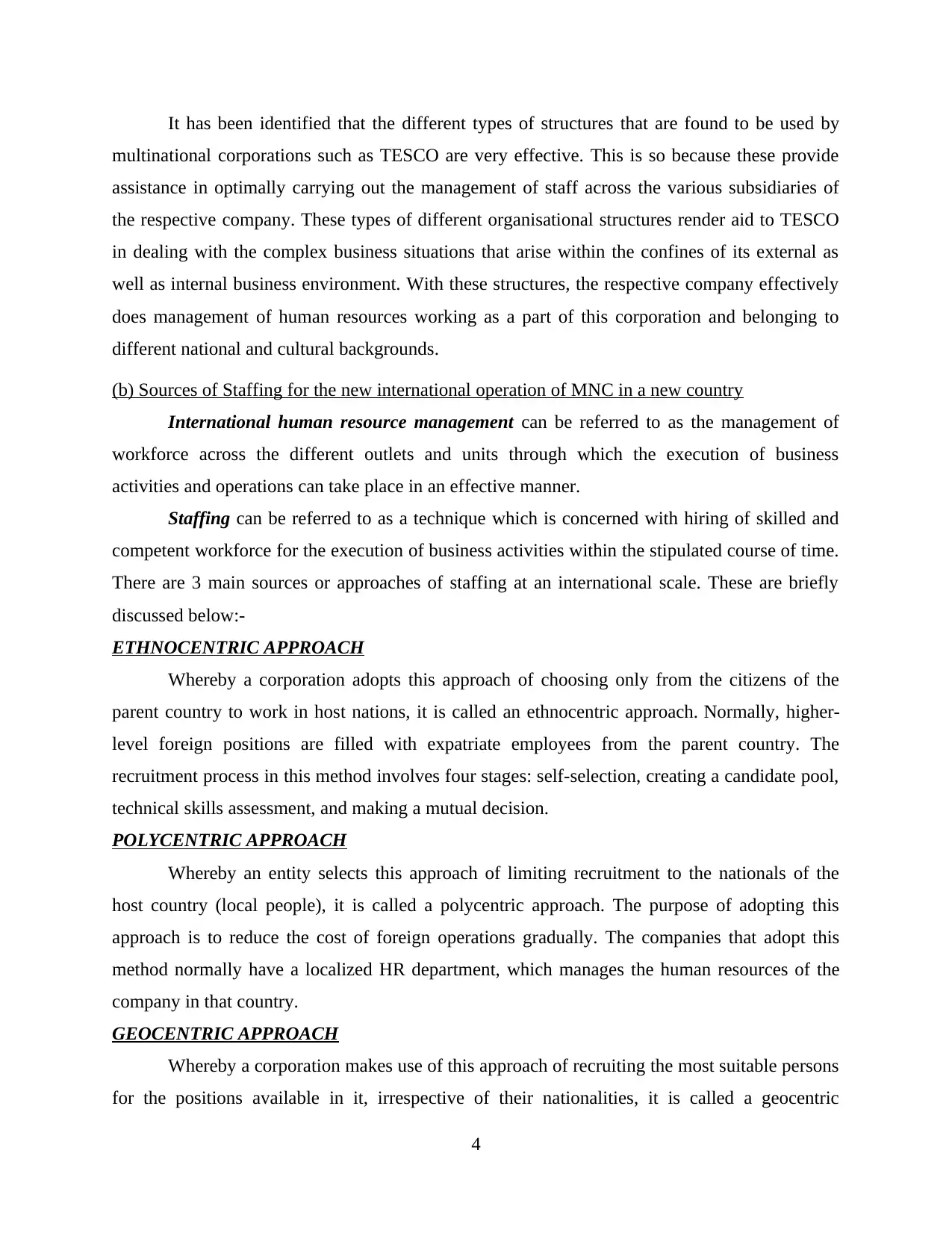
It has been identified that the different types of structures that are found to be used by
multinational corporations such as TESCO are very effective. This is so because these provide
assistance in optimally carrying out the management of staff across the various subsidiaries of
the respective company. These types of different organisational structures render aid to TESCO
in dealing with the complex business situations that arise within the confines of its external as
well as internal business environment. With these structures, the respective company effectively
does management of human resources working as a part of this corporation and belonging to
different national and cultural backgrounds.
(b) Sources of Staffing for the new international operation of MNC in a new country
International human resource management can be referred to as the management of
workforce across the different outlets and units through which the execution of business
activities and operations can take place in an effective manner.
Staffing can be referred to as a technique which is concerned with hiring of skilled and
competent workforce for the execution of business activities within the stipulated course of time.
There are 3 main sources or approaches of staffing at an international scale. These are briefly
discussed below:-
ETHNOCENTRIC APPROACH
Whereby a corporation adopts this approach of choosing only from the citizens of the
parent country to work in host nations, it is called an ethnocentric approach. Normally, higher-
level foreign positions are filled with expatriate employees from the parent country. The
recruitment process in this method involves four stages: self-selection, creating a candidate pool,
technical skills assessment, and making a mutual decision.
POLYCENTRIC APPROACH
Whereby an entity selects this approach of limiting recruitment to the nationals of the
host country (local people), it is called a polycentric approach. The purpose of adopting this
approach is to reduce the cost of foreign operations gradually. The companies that adopt this
method normally have a localized HR department, which manages the human resources of the
company in that country.
GEOCENTRIC APPROACH
Whereby a corporation makes use of this approach of recruiting the most suitable persons
for the positions available in it, irrespective of their nationalities, it is called a geocentric
4
multinational corporations such as TESCO are very effective. This is so because these provide
assistance in optimally carrying out the management of staff across the various subsidiaries of
the respective company. These types of different organisational structures render aid to TESCO
in dealing with the complex business situations that arise within the confines of its external as
well as internal business environment. With these structures, the respective company effectively
does management of human resources working as a part of this corporation and belonging to
different national and cultural backgrounds.
(b) Sources of Staffing for the new international operation of MNC in a new country
International human resource management can be referred to as the management of
workforce across the different outlets and units through which the execution of business
activities and operations can take place in an effective manner.
Staffing can be referred to as a technique which is concerned with hiring of skilled and
competent workforce for the execution of business activities within the stipulated course of time.
There are 3 main sources or approaches of staffing at an international scale. These are briefly
discussed below:-
ETHNOCENTRIC APPROACH
Whereby a corporation adopts this approach of choosing only from the citizens of the
parent country to work in host nations, it is called an ethnocentric approach. Normally, higher-
level foreign positions are filled with expatriate employees from the parent country. The
recruitment process in this method involves four stages: self-selection, creating a candidate pool,
technical skills assessment, and making a mutual decision.
POLYCENTRIC APPROACH
Whereby an entity selects this approach of limiting recruitment to the nationals of the
host country (local people), it is called a polycentric approach. The purpose of adopting this
approach is to reduce the cost of foreign operations gradually. The companies that adopt this
method normally have a localized HR department, which manages the human resources of the
company in that country.
GEOCENTRIC APPROACH
Whereby a corporation makes use of this approach of recruiting the most suitable persons
for the positions available in it, irrespective of their nationalities, it is called a geocentric
4
Paraphrase This Document
Need a fresh take? Get an instant paraphrase of this document with our AI Paraphraser
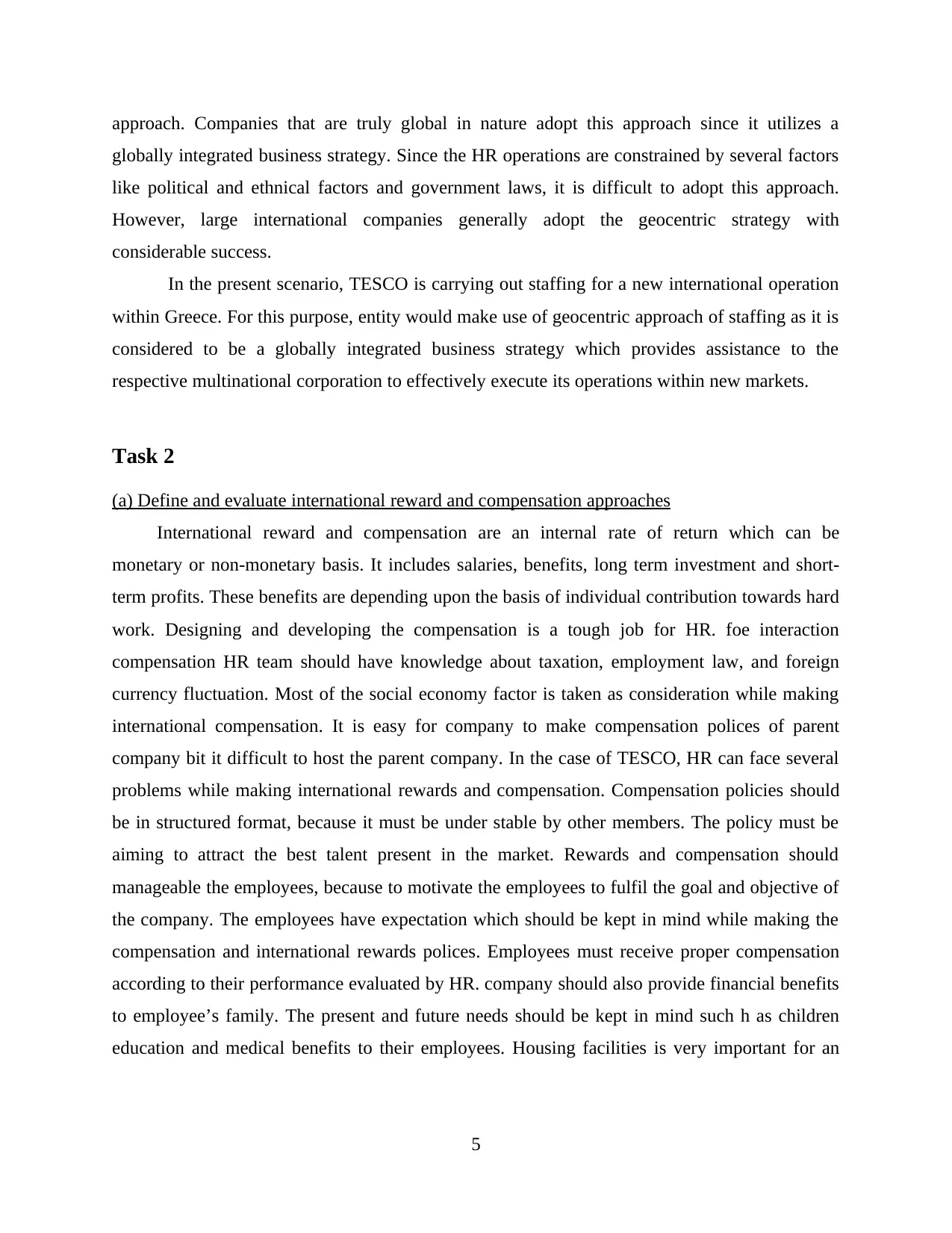
approach. Companies that are truly global in nature adopt this approach since it utilizes a
globally integrated business strategy. Since the HR operations are constrained by several factors
like political and ethnical factors and government laws, it is difficult to adopt this approach.
However, large international companies generally adopt the geocentric strategy with
considerable success.
In the present scenario, TESCO is carrying out staffing for a new international operation
within Greece. For this purpose, entity would make use of geocentric approach of staffing as it is
considered to be a globally integrated business strategy which provides assistance to the
respective multinational corporation to effectively execute its operations within new markets.
Task 2
(a) Define and evaluate international reward and compensation approaches
International reward and compensation are an internal rate of return which can be
monetary or non-monetary basis. It includes salaries, benefits, long term investment and short-
term profits. These benefits are depending upon the basis of individual contribution towards hard
work. Designing and developing the compensation is a tough job for HR. foe interaction
compensation HR team should have knowledge about taxation, employment law, and foreign
currency fluctuation. Most of the social economy factor is taken as consideration while making
international compensation. It is easy for company to make compensation polices of parent
company bit it difficult to host the parent company. In the case of TESCO, HR can face several
problems while making international rewards and compensation. Compensation policies should
be in structured format, because it must be under stable by other members. The policy must be
aiming to attract the best talent present in the market. Rewards and compensation should
manageable the employees, because to motivate the employees to fulfil the goal and objective of
the company. The employees have expectation which should be kept in mind while making the
compensation and international rewards polices. Employees must receive proper compensation
according to their performance evaluated by HR. company should also provide financial benefits
to employee’s family. The present and future needs should be kept in mind such h as children
education and medical benefits to their employees. Housing facilities is very important for an
5
globally integrated business strategy. Since the HR operations are constrained by several factors
like political and ethnical factors and government laws, it is difficult to adopt this approach.
However, large international companies generally adopt the geocentric strategy with
considerable success.
In the present scenario, TESCO is carrying out staffing for a new international operation
within Greece. For this purpose, entity would make use of geocentric approach of staffing as it is
considered to be a globally integrated business strategy which provides assistance to the
respective multinational corporation to effectively execute its operations within new markets.
Task 2
(a) Define and evaluate international reward and compensation approaches
International reward and compensation are an internal rate of return which can be
monetary or non-monetary basis. It includes salaries, benefits, long term investment and short-
term profits. These benefits are depending upon the basis of individual contribution towards hard
work. Designing and developing the compensation is a tough job for HR. foe interaction
compensation HR team should have knowledge about taxation, employment law, and foreign
currency fluctuation. Most of the social economy factor is taken as consideration while making
international compensation. It is easy for company to make compensation polices of parent
company bit it difficult to host the parent company. In the case of TESCO, HR can face several
problems while making international rewards and compensation. Compensation policies should
be in structured format, because it must be under stable by other members. The policy must be
aiming to attract the best talent present in the market. Rewards and compensation should
manageable the employees, because to motivate the employees to fulfil the goal and objective of
the company. The employees have expectation which should be kept in mind while making the
compensation and international rewards polices. Employees must receive proper compensation
according to their performance evaluated by HR. company should also provide financial benefits
to employee’s family. The present and future needs should be kept in mind such h as children
education and medical benefits to their employees. Housing facilities is very important for an
5
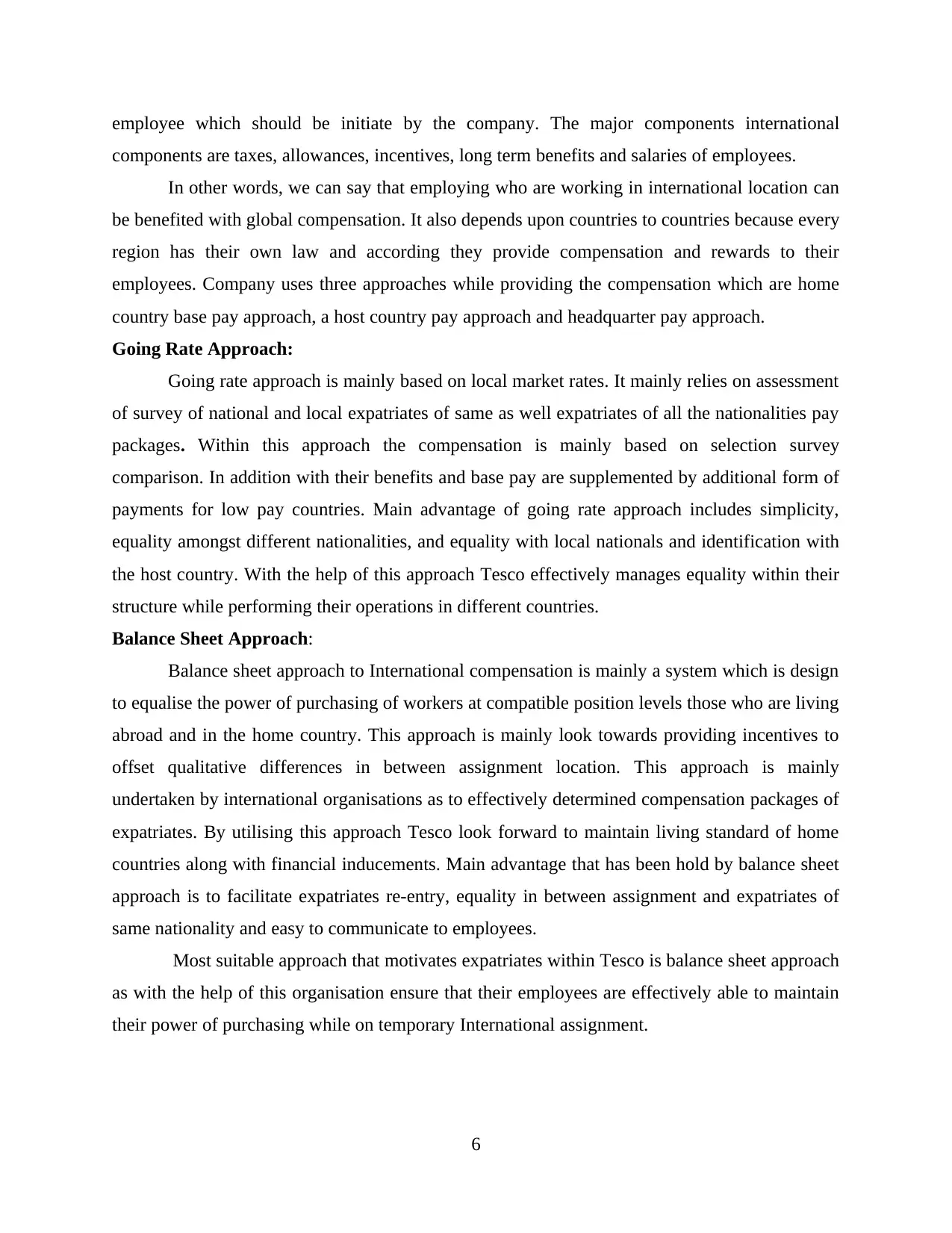
employee which should be initiate by the company. The major components international
components are taxes, allowances, incentives, long term benefits and salaries of employees.
In other words, we can say that employing who are working in international location can
be benefited with global compensation. It also depends upon countries to countries because every
region has their own law and according they provide compensation and rewards to their
employees. Company uses three approaches while providing the compensation which are home
country base pay approach, a host country pay approach and headquarter pay approach.
Going Rate Approach:
Going rate approach is mainly based on local market rates. It mainly relies on assessment
of survey of national and local expatriates of same as well expatriates of all the nationalities pay
packages. Within this approach the compensation is mainly based on selection survey
comparison. In addition with their benefits and base pay are supplemented by additional form of
payments for low pay countries. Main advantage of going rate approach includes simplicity,
equality amongst different nationalities, and equality with local nationals and identification with
the host country. With the help of this approach Tesco effectively manages equality within their
structure while performing their operations in different countries.
Balance Sheet Approach:
Balance sheet approach to International compensation is mainly a system which is design
to equalise the power of purchasing of workers at compatible position levels those who are living
abroad and in the home country. This approach is mainly look towards providing incentives to
offset qualitative differences in between assignment location. This approach is mainly
undertaken by international organisations as to effectively determined compensation packages of
expatriates. By utilising this approach Tesco look forward to maintain living standard of home
countries along with financial inducements. Main advantage that has been hold by balance sheet
approach is to facilitate expatriates re-entry, equality in between assignment and expatriates of
same nationality and easy to communicate to employees.
Most suitable approach that motivates expatriates within Tesco is balance sheet approach
as with the help of this organisation ensure that their employees are effectively able to maintain
their power of purchasing while on temporary International assignment.
6
components are taxes, allowances, incentives, long term benefits and salaries of employees.
In other words, we can say that employing who are working in international location can
be benefited with global compensation. It also depends upon countries to countries because every
region has their own law and according they provide compensation and rewards to their
employees. Company uses three approaches while providing the compensation which are home
country base pay approach, a host country pay approach and headquarter pay approach.
Going Rate Approach:
Going rate approach is mainly based on local market rates. It mainly relies on assessment
of survey of national and local expatriates of same as well expatriates of all the nationalities pay
packages. Within this approach the compensation is mainly based on selection survey
comparison. In addition with their benefits and base pay are supplemented by additional form of
payments for low pay countries. Main advantage of going rate approach includes simplicity,
equality amongst different nationalities, and equality with local nationals and identification with
the host country. With the help of this approach Tesco effectively manages equality within their
structure while performing their operations in different countries.
Balance Sheet Approach:
Balance sheet approach to International compensation is mainly a system which is design
to equalise the power of purchasing of workers at compatible position levels those who are living
abroad and in the home country. This approach is mainly look towards providing incentives to
offset qualitative differences in between assignment location. This approach is mainly
undertaken by international organisations as to effectively determined compensation packages of
expatriates. By utilising this approach Tesco look forward to maintain living standard of home
countries along with financial inducements. Main advantage that has been hold by balance sheet
approach is to facilitate expatriates re-entry, equality in between assignment and expatriates of
same nationality and easy to communicate to employees.
Most suitable approach that motivates expatriates within Tesco is balance sheet approach
as with the help of this organisation ensure that their employees are effectively able to maintain
their power of purchasing while on temporary International assignment.
6
⊘ This is a preview!⊘
Do you want full access?
Subscribe today to unlock all pages.

Trusted by 1+ million students worldwide
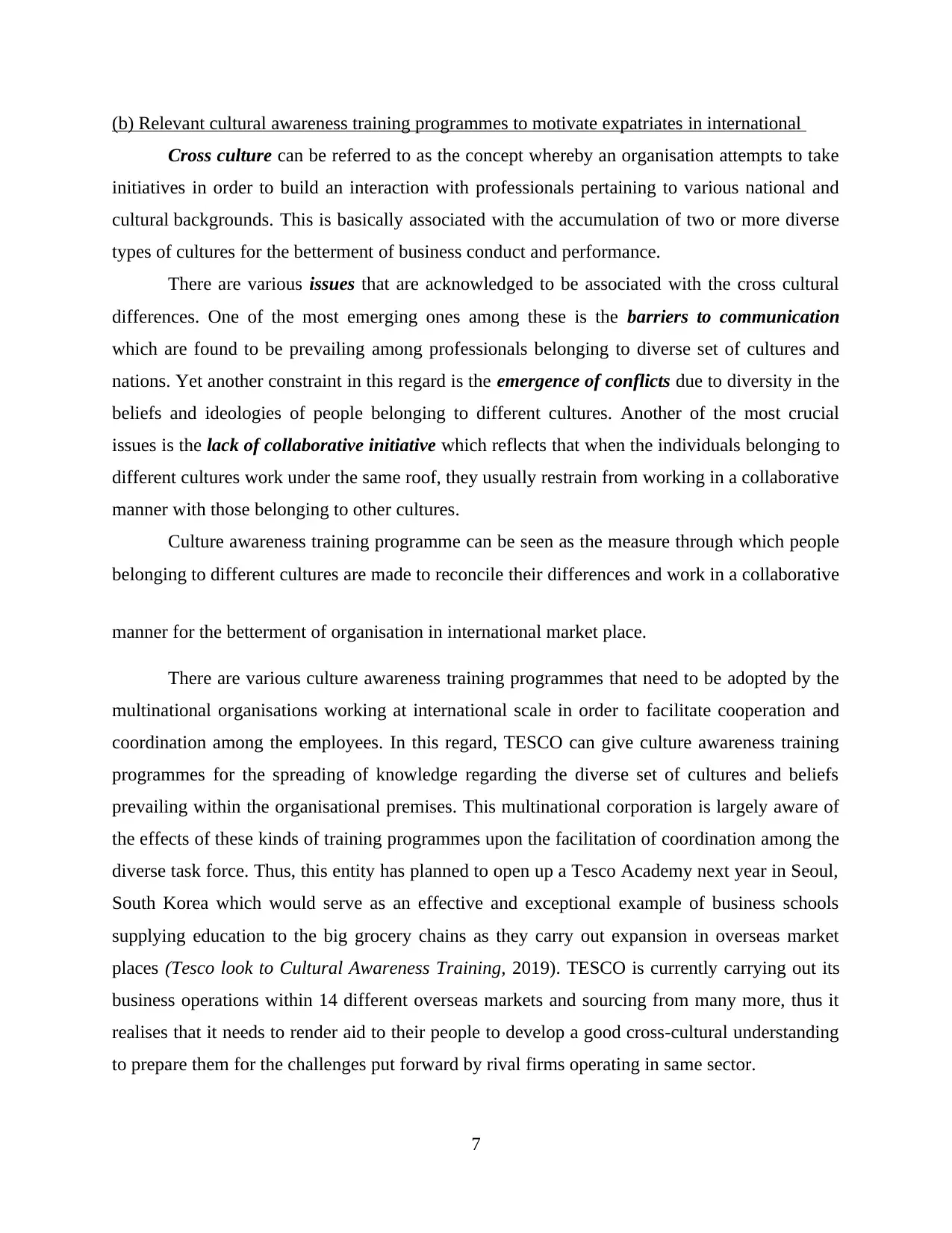
(b) Relevant cultural awareness training programmes to motivate expatriates in international
Cross culture can be referred to as the concept whereby an organisation attempts to take
initiatives in order to build an interaction with professionals pertaining to various national and
cultural backgrounds. This is basically associated with the accumulation of two or more diverse
types of cultures for the betterment of business conduct and performance.
There are various issues that are acknowledged to be associated with the cross cultural
differences. One of the most emerging ones among these is the barriers to communication
which are found to be prevailing among professionals belonging to diverse set of cultures and
nations. Yet another constraint in this regard is the emergence of conflicts due to diversity in the
beliefs and ideologies of people belonging to different cultures. Another of the most crucial
issues is the lack of collaborative initiative which reflects that when the individuals belonging to
different cultures work under the same roof, they usually restrain from working in a collaborative
manner with those belonging to other cultures.
Culture awareness training programme can be seen as the measure through which people
belonging to different cultures are made to reconcile their differences and work in a collaborative
manner for the betterment of organisation in international market place.
There are various culture awareness training programmes that need to be adopted by the
multinational organisations working at international scale in order to facilitate cooperation and
coordination among the employees. In this regard, TESCO can give culture awareness training
programmes for the spreading of knowledge regarding the diverse set of cultures and beliefs
prevailing within the organisational premises. This multinational corporation is largely aware of
the effects of these kinds of training programmes upon the facilitation of coordination among the
diverse task force. Thus, this entity has planned to open up a Tesco Academy next year in Seoul,
South Korea which would serve as an effective and exceptional example of business schools
supplying education to the big grocery chains as they carry out expansion in overseas market
places (Tesco look to Cultural Awareness Training, 2019). TESCO is currently carrying out its
business operations within 14 different overseas markets and sourcing from many more, thus it
realises that it needs to render aid to their people to develop a good cross-cultural understanding
to prepare them for the challenges put forward by rival firms operating in same sector.
7
Cross culture can be referred to as the concept whereby an organisation attempts to take
initiatives in order to build an interaction with professionals pertaining to various national and
cultural backgrounds. This is basically associated with the accumulation of two or more diverse
types of cultures for the betterment of business conduct and performance.
There are various issues that are acknowledged to be associated with the cross cultural
differences. One of the most emerging ones among these is the barriers to communication
which are found to be prevailing among professionals belonging to diverse set of cultures and
nations. Yet another constraint in this regard is the emergence of conflicts due to diversity in the
beliefs and ideologies of people belonging to different cultures. Another of the most crucial
issues is the lack of collaborative initiative which reflects that when the individuals belonging to
different cultures work under the same roof, they usually restrain from working in a collaborative
manner with those belonging to other cultures.
Culture awareness training programme can be seen as the measure through which people
belonging to different cultures are made to reconcile their differences and work in a collaborative
manner for the betterment of organisation in international market place.
There are various culture awareness training programmes that need to be adopted by the
multinational organisations working at international scale in order to facilitate cooperation and
coordination among the employees. In this regard, TESCO can give culture awareness training
programmes for the spreading of knowledge regarding the diverse set of cultures and beliefs
prevailing within the organisational premises. This multinational corporation is largely aware of
the effects of these kinds of training programmes upon the facilitation of coordination among the
diverse task force. Thus, this entity has planned to open up a Tesco Academy next year in Seoul,
South Korea which would serve as an effective and exceptional example of business schools
supplying education to the big grocery chains as they carry out expansion in overseas market
places (Tesco look to Cultural Awareness Training, 2019). TESCO is currently carrying out its
business operations within 14 different overseas markets and sourcing from many more, thus it
realises that it needs to render aid to their people to develop a good cross-cultural understanding
to prepare them for the challenges put forward by rival firms operating in same sector.
7
Paraphrase This Document
Need a fresh take? Get an instant paraphrase of this document with our AI Paraphraser
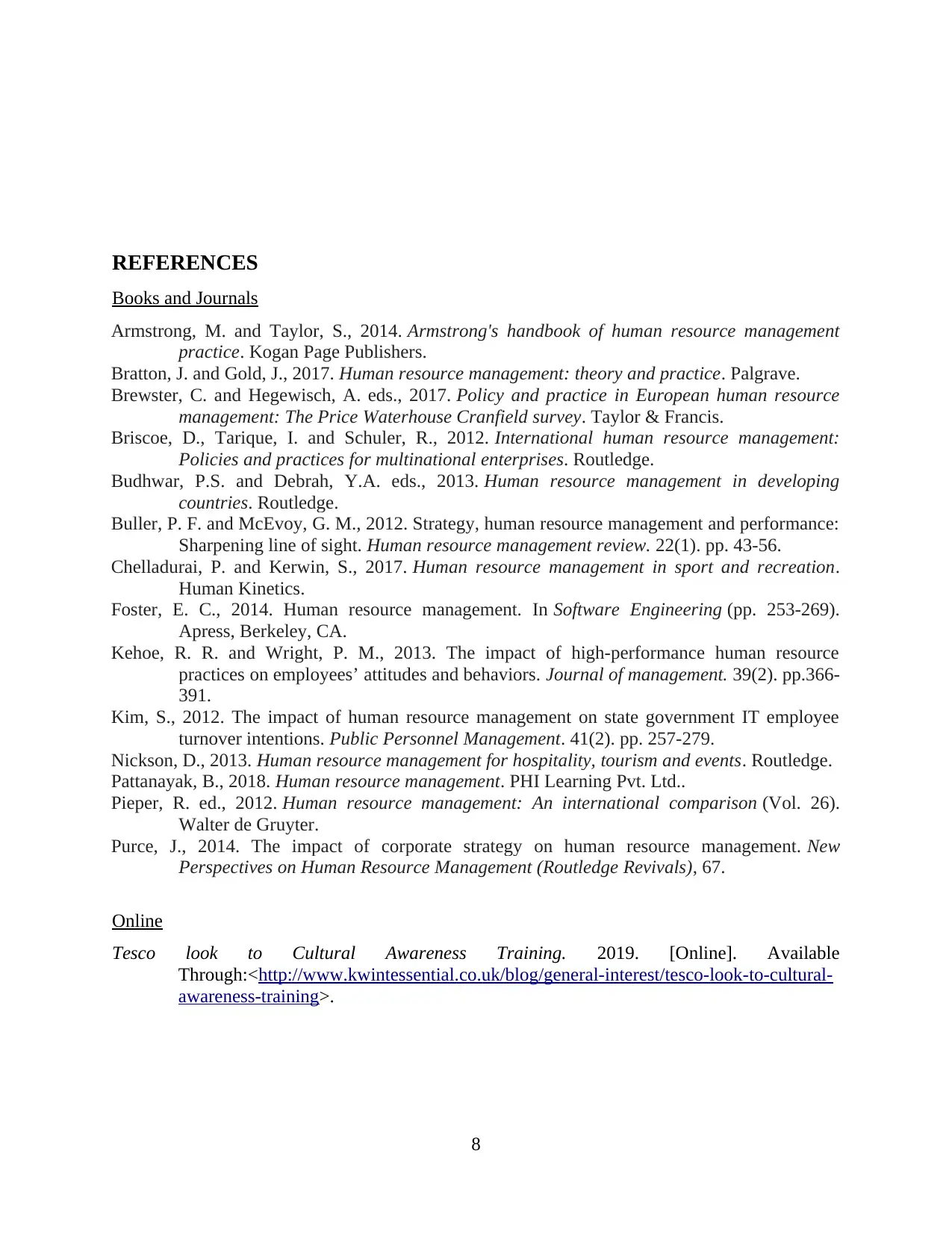
REFERENCES
Books and Journals
Armstrong, M. and Taylor, S., 2014. Armstrong's handbook of human resource management
practice. Kogan Page Publishers.
Bratton, J. and Gold, J., 2017. Human resource management: theory and practice. Palgrave.
Brewster, C. and Hegewisch, A. eds., 2017. Policy and practice in European human resource
management: The Price Waterhouse Cranfield survey. Taylor & Francis.
Briscoe, D., Tarique, I. and Schuler, R., 2012. International human resource management:
Policies and practices for multinational enterprises. Routledge.
Budhwar, P.S. and Debrah, Y.A. eds., 2013. Human resource management in developing
countries. Routledge.
Buller, P. F. and McEvoy, G. M., 2012. Strategy, human resource management and performance:
Sharpening line of sight. Human resource management review. 22(1). pp. 43-56.
Chelladurai, P. and Kerwin, S., 2017. Human resource management in sport and recreation.
Human Kinetics.
Foster, E. C., 2014. Human resource management. In Software Engineering (pp. 253-269).
Apress, Berkeley, CA.
Kehoe, R. R. and Wright, P. M., 2013. The impact of high-performance human resource
practices on employees’ attitudes and behaviors. Journal of management. 39(2). pp.366-
391.
Kim, S., 2012. The impact of human resource management on state government IT employee
turnover intentions. Public Personnel Management. 41(2). pp. 257-279.
Nickson, D., 2013. Human resource management for hospitality, tourism and events. Routledge.
Pattanayak, B., 2018. Human resource management. PHI Learning Pvt. Ltd..
Pieper, R. ed., 2012. Human resource management: An international comparison (Vol. 26).
Walter de Gruyter.
Purce, J., 2014. The impact of corporate strategy on human resource management. New
Perspectives on Human Resource Management (Routledge Revivals), 67.
Online
Tesco look to Cultural Awareness Training. 2019. [Online]. Available
Through:<http://www.kwintessential.co.uk/blog/general-interest/tesco-look-to-cultural-
awareness-training>.
8
Books and Journals
Armstrong, M. and Taylor, S., 2014. Armstrong's handbook of human resource management
practice. Kogan Page Publishers.
Bratton, J. and Gold, J., 2017. Human resource management: theory and practice. Palgrave.
Brewster, C. and Hegewisch, A. eds., 2017. Policy and practice in European human resource
management: The Price Waterhouse Cranfield survey. Taylor & Francis.
Briscoe, D., Tarique, I. and Schuler, R., 2012. International human resource management:
Policies and practices for multinational enterprises. Routledge.
Budhwar, P.S. and Debrah, Y.A. eds., 2013. Human resource management in developing
countries. Routledge.
Buller, P. F. and McEvoy, G. M., 2012. Strategy, human resource management and performance:
Sharpening line of sight. Human resource management review. 22(1). pp. 43-56.
Chelladurai, P. and Kerwin, S., 2017. Human resource management in sport and recreation.
Human Kinetics.
Foster, E. C., 2014. Human resource management. In Software Engineering (pp. 253-269).
Apress, Berkeley, CA.
Kehoe, R. R. and Wright, P. M., 2013. The impact of high-performance human resource
practices on employees’ attitudes and behaviors. Journal of management. 39(2). pp.366-
391.
Kim, S., 2012. The impact of human resource management on state government IT employee
turnover intentions. Public Personnel Management. 41(2). pp. 257-279.
Nickson, D., 2013. Human resource management for hospitality, tourism and events. Routledge.
Pattanayak, B., 2018. Human resource management. PHI Learning Pvt. Ltd..
Pieper, R. ed., 2012. Human resource management: An international comparison (Vol. 26).
Walter de Gruyter.
Purce, J., 2014. The impact of corporate strategy on human resource management. New
Perspectives on Human Resource Management (Routledge Revivals), 67.
Online
Tesco look to Cultural Awareness Training. 2019. [Online]. Available
Through:<http://www.kwintessential.co.uk/blog/general-interest/tesco-look-to-cultural-
awareness-training>.
8
1 out of 8
Related Documents
Your All-in-One AI-Powered Toolkit for Academic Success.
+13062052269
info@desklib.com
Available 24*7 on WhatsApp / Email
![[object Object]](/_next/static/media/star-bottom.7253800d.svg)
Unlock your academic potential
Copyright © 2020–2025 A2Z Services. All Rights Reserved. Developed and managed by ZUCOL.




